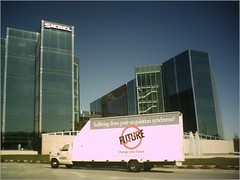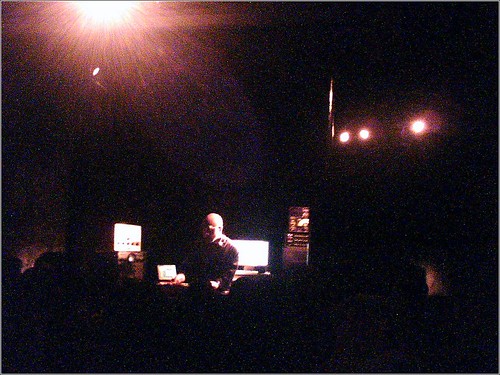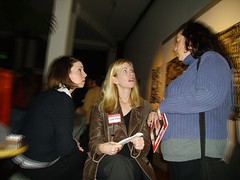Brian Carroll: “Lead generation is a conversation, a dialogue; it is not a series of campaigns. Again, companies don’t buy; people do. This mindset can open up a whole new set of possibilities.”
The Social Customer Manifesto Podcast 27JAN2006
Summary: Leif Chastaine and Christopher Carfi discuss the American Marketing Association’s “Ahead of the Curve” session in Chicago, the marketing challenge for RSS, Salesforce.com taunts and tempts Siebel employees, launch of the “Healing Space” health and environment blog, and this week’s RIM/BlackBerry Supreme Court decision. (33:32)
Show notes for January 27, 2006
The audio file is available here (MP3, 32MB), or subscribe to our RSS feed to automatically have future shows downloaded to your MP3 player.
00:00 : Intro
01:10 : Recap of the AMA’s Ahead of the Curve session: High Tech Trends in Marketing
02:40 : What is RSS?
Metaphors:
Google search for RSS metaphors (n.b. and yes, actually these are “similes” and not “metaphors,” we know, we know…)
“RSS is like an API for content”
“RSS is like selling dogfood over the internet”
“RSS is like Tivo for the web”
“Explaining RSS is like explaining sex. You just don’t get it until you do it.” (also here)
Dave Winer
11:45 : Salesforce.com to Siebel employees: “No Future“
19:30 : Healing Space health, wellness and environment blog launched
25:15 : Supremes won’t intervene in RIM BlackBerry / NTP dispute
33:50 : Wrapup
Links:
Bill Flitter, Stowe Boyd, Randy Moss, Michael Sevilla, TheCradle, Salesforce.com, Siebel, Paul Greenberg, Todd Pesek, EarthHealers, Naturaleza Foundation, eco-tourism, Craig Williams, Howard Bashman, Research in Motion, BlackBerry, Ross Mayfield, Davos, BlackBerries a matter of national security
Business Blogging At IBM
Julie Alterio at The Journal News has a decent article up on the scope of blogging initiatives within Big Blue and other organizations. Irving Wladawsky-Berger, IBM’s VP of technical strategy and innovation is quoted as saying:
“We absolutely recognize that blogging, just like the Internet, World Wide Web, Linux and open source, is a major initiative in the marketplace that we should be part of. This best way to be part of it is not to observe it passively but to do it actively.”
Sound advice.
And, although the article is primarily about the view on business blogging from within IBM and other large companies, Dave Sifry gets into the act as well. And NAILS his line. Way to go, Dave…
“In the world of the Internet, you don’t own your brand. Your customers and your users own your brand. You’re lucky if you get to shepherd it.”
Firsthand Blogging Accounts Of Healing and Conservation, Live From The Rainforest

My amigo Dr. Todd Pesek has just set up his new blog, Healing Space. His first post is here.
Denise and I have been helping him get it set up and launched. It’s kinda like what Hugh did with English Cut, but in the rainforest.
If you’re interested in health or conservation, Todd is someone who should be on your radar. Got his M.D. from the the Ohio State University College of Medicine and Public Health and the Cleveland Clinic Foundation. Founded his company Earth Healers to do eco-learning tours and to find ways to bridge the gap between standard “Western” healing and things that have been learned by indigenous cultures over the past few millenia. Is a director of the Naturaleza Foundation, which concentrates on global health/wellness, sustainable agriculture, education and cultural awareness. And is, in general, a helluva guy.
He’s also a listener and a learner. (At the risk of gross generalization, I’ve known plenty of people with similar credentials who were certain they knew it all, regardless of the topic…just ask ’em! Todd is not one of those people.) As such, when we were setting up his blog, he wanted to be certain that he would be able to engage in conversation with folks who came to the site via his comments.
I assured him that the blogosphere was not shy.
So, anyone up for going on a learning trip to Machu Picchu? Getting on a plane to Belize to find out firsthand about surviving in the jungle? Going on a biodiversity retreat in Guatemala? If so, give Todd a shout.
(Subscribed. His RSS feed is here: Healing Space.)
Salesforce.com’s Latest PsyOp Against Siebel
“To seduce the enemies soldiers from their allegiance and encourage them to surrender is of special service, for an adversary is more hurt by desertion than by slaughter.” — Vegetius, ca. 390 A.D.
It appears that Marc Benioff and his minions are up to their new/old tricks, this time in San Mateo, CA. Through utter and sheer coincidence, I happened to be driving through the intersection in front of Siebel’s offices today, and what do I see? Not one, but TWO Salesforce.com billboard trucks circling the building on two-minute intervals (it’s not a very big block).
The text on the trucks reads (click the pics to enlarge):
Suffering from post-acquisition syndrome?
[circle-slash through “FUTURE”]
Change your future.
(This harkens back to SFDC’s “picketing” of past Siebel events, and Benioff’s continued unhealthy fascination with both Tom Siebel and Larry Ellison.)
On one hand, this kind of stuff evokes a chuckle. On the other, Paul Greenberg had two great posts on this type of behavior that is increasingly endemic in the industry. The money quotes:
“Its time to stop this crap now – at least with me. I truly don’t care if you have some gloating piece of information on “you’re better than they are because they suck at this.”
I think that its about time for the On Demand crowd to recognize they are a major force in the business world now and they have to act like it.
Or maybe they are acting like it.
All I know is that I find the “tactic” of demeaning ones opponent rather than competing on the merits and value of the applications or services or products to the customer dismaying and disgusting.” – from here
and
“I’m going to reiterate something I’ve said before. The On Demand world needs to stop this ADD [“Attack, Demean, Degrade”] offensive. It is deeply offensive because it is just so damned childish.
What makes this dangerous is that On Demand will be the dominant force in CRM without a doubt very soon and will be the dominant platform for the customer experience over the next few years. Do you want your customer’s experience run by an industry that loves to spit bile?” – from here
Louis Columbus also chimes in with a gem: “Denigrating competitors is a sign that companies doing the slamming don’t really and truly have enough faith in their own applications to sell on the value they deliver. Taking the low road of celebrating a competitor’s misfortune makes you wonder how a company feels about valuable, yet sometimes difficult customers pushing the limits of applications and services…”
Despite the brief amusements they provide, “vendor sports” (a term I believe Doc Searls coined, more refs here) really do, ultimately, hurt the customer. Why? Because the combatants are investing their time, energy and creativity in tasks that ultimate are nothing more than the Silicon Valley equivalent of chest-thumping and locker-room comparisons instead of focusing their scarce resources on the things that improve the customer experience.
tags: appexchange, ondemand, oracle, SaaS, salesforce, salesforce.com, siebel
OffTopic: Thomas Dolby At The Red Devil Lounge, SF
Quote of the evening: “I will now do a medley of my hit.”
(Actually last night was a great set. Maybe 200 people in the audience, and RDL is a small venue. First time he’s played out since 1988, and first time he’s done a one-man show since 1981. He’s tuning up for a tour…)
A Lifehack For Those Who Fly On Southwest Airlines
Heh.
As I was getting ready to take the El to the airport today, I realized that I had a problem. Since I was flying on Southwest, the earlier the check-in the better, as a result of their “Group A-B-C” boarding policy. Yet, I was in my hotel room and did not have a printer…although I could check-in online, I wouldn’t be able to print my boarding pass, effectively putting me in a Catch-22.
If I didn’t check-in before I left the hotel, I’d be destined for a “Group C” boarding experience. But if I did check-in online, I wouldn’t have a boarding pass to get through security. What to do?
Then I remembered “the magic option” on the Southwest Airlines kiosks that I had seen when I had checked in for my outbound flight. That magic option? “Reprint Boarding Pass.” (I had actually needed to use this option when checking in for my outbound flight, as the first boarding pass had jammed coming out of the printer and had been ripped to ribbons in the process.)
Here’s how this little trick works:
1) Before leaving the hotel (or even the night before), go online and check-in for the flight. The southwest.com site checks you in. Then your browser shows your boarding pass, and puts you in the “group” you’re qualified for by virtue of checking in early. After you’re checked in, close your browser window. (In normal circumstances, such as at home or at the office, you’d actually print this out.)
2) Go to the airport
3) Find the nearest Southwest kiosk
4) Put in your ID, and up comes your reservation.
5) Press “reprint boarding pass” (in the lower right-hand corner) and retrieve your reward for being just a little more wily than the average bear.
6) Voila! “Group A” check-ins, nearly every time!
Live From The Gleacher Center
 In the session at Ahead of the Curve.
In the session at Ahead of the Curve.
Stowe just finished up a great overview on blogs, blogging and podcasting, and now Bill Flitter is just finishing his presentation. The big take-away for me … RSS is still too complex. It’s too complex to explain … too complex to subscribe … too complex to “show” what an RSS feed is … too complex to communicate how and why it matters.
Once we get beyond the early-adopter crowd, what are the capabilities and metaphors that are needed to enable RSS to become so ubiquitous that we don’t need to go through the nitty-gritty details? (In other words…I don’t want to know how the internal combustion engine operates, I just want to reliably get to my destination.) Back in August, 2005, Chris Selland wrote:
“RSS is still very much the realm of early adopters (which is why only early-adopter-focused companies like Audible, Woot and HDNet are using it). But as RSS readers become more powerful and more ubiquitous – and particularly as they become more closely entwined with e-mail applications – expect the use of RSS to dramatically accelerate – much of it at the expense of e-mail.”
This is still on-target.
Randy Moss is now up presenting the first part of the social networking discussion, and talking about directed apophenia, and leading into a group exercise. Everyone in the room is up at the front of the room, showing their connections to the others in the room, via past experiences, hobbies, hometowns, schools, products/brands they are passionate about, and the like. (By the way, Randy’s book recommendation of the day: The Hidden Power of Social Networks by Rob Cross.)
Randy: “It’s critical for organizations to host communities. If a company does this, they’re the good guy, they are the one who is providing the network for individuals to connect.” (bravo!)
Michael Sevilla from Umbria is now presenting a state of the blogosphere preso. Now moving into a discussion of promoters and detractors, and is highlighting the Qwest’s Terms of Service flap. (Michael was affected by it.)
VERY interesting. Now going through things that one can do with OpinMind. For example, blog sentiment of Microsoft and Apple. (N.B. Kind of a neat tool, but it does not seem to have a deep listing of sources. Hopefully it’ll grow more over time.)
fin
(top photo: UChicago)
Thoughts For The Beginning Blogger
One of our clients is starting to charge full-force down the blogging path and asked for some feedback on the posts they were working on. Not going to get into the details of what they’re working on quite yet, but had some thoughts that I was sending over based on reading the initial bits that were being put together. About halfway through, realized that these items were fairly relevant across-the-board, so here they are. What would you add to this as far as suggestions for someone just starting down the blogging path?
“G-
First off … Every successful blog eventually has a voice and a corresponding “positioning” (sorry for the marketingspeak) that is applied to it by its readers. The voice of the blog will evolve and, just like positioning in the pure marketing sense, a “tone” of the blog will be applied to you by your subscribers. This will take some time, but if you have a feeling as to how you would *like* to be positioned, you can certainly help it along via the choice of name, categories, commonly-used phrases, etc. Think about what you want the blog’s mojo to be: is it an inside look at the tales of a startup? Is it a viewpoint and *the* reference on long-tail software, or perhaps SaaS? Something else?
Think about your blog’s tagline. (The tagline WILL be reproduced elsewhere, so try to make it capture the core of whatever theme you want to tie everything together.) If the theme is still evolving, it may take a couple of months for the right tagline to present itself…and it will probably uncerimoniously assault you in the shower in the pre-caffeinated hours one morning. But it will show up. Write it down and integrate it when it does.
The positioning and general mojo are ultimately critical…but short-term irrelevant. Just write. Then write some more. It’ll evolve, and don’t force it. It took about four months after inception for the Social Customer blog to find its voice.
Additionally, a well-conceived and executed “About” page is a must, as is a picture. A well-written post will trigger a click to the About page which will, if also well-executed, trigger a click back to the mothership. Make the About page personal. It’s you!
A couple of other general thoughts:
– More links to other blogs inlined in the text! As a result of the current state of measurement and search tools, bloggers are narcissistic link whores (it’s all about the Googlejuice, baby). The more links you throw out to others, (a) the more likely someone will come to your blog (since they saw your blog show up in their vanity feed in Technorati) and (b) they may even put a reciprocal link in one of their posts in the next week, pointing to “hey….here’s a cool article on *x*” that shows how you can use whatever they are pimping in doing *x*. If you can’t link to a blog, link to a news article. If you can’t link to a news article, link to a product site. But link! As Anthony Kiedis so eloquently put it…give it away, give it away, give it away now. (However, for the love of all that is good and right in the world, please refrain from experimenting with RHCP tube sock attire. ::shudder::)
Last, but certainly not least, make sure you have an RSS feed that can be subscribed to on Day 1. Get readers on the drip. First one’s free…
best,
c”
SXSW Reception
A few shots from last night’s SXSW Reception at 111 Minna in San Francisco. Click ’em to make them larger, etc.
(Happily, was too busy being social to take very many.)
The 111 Minna space is currently featuring an exhibition called A Year and a Day, and their archives of past exhibitions can be found here.
tags: sxsw









